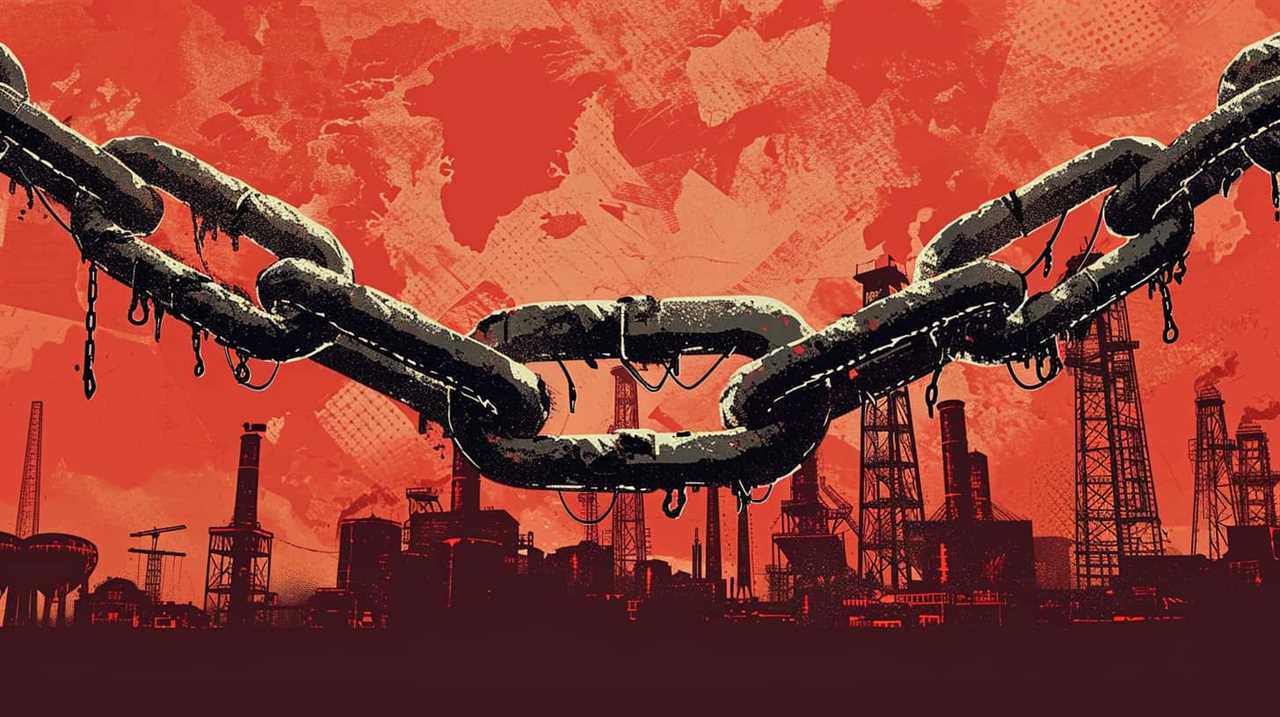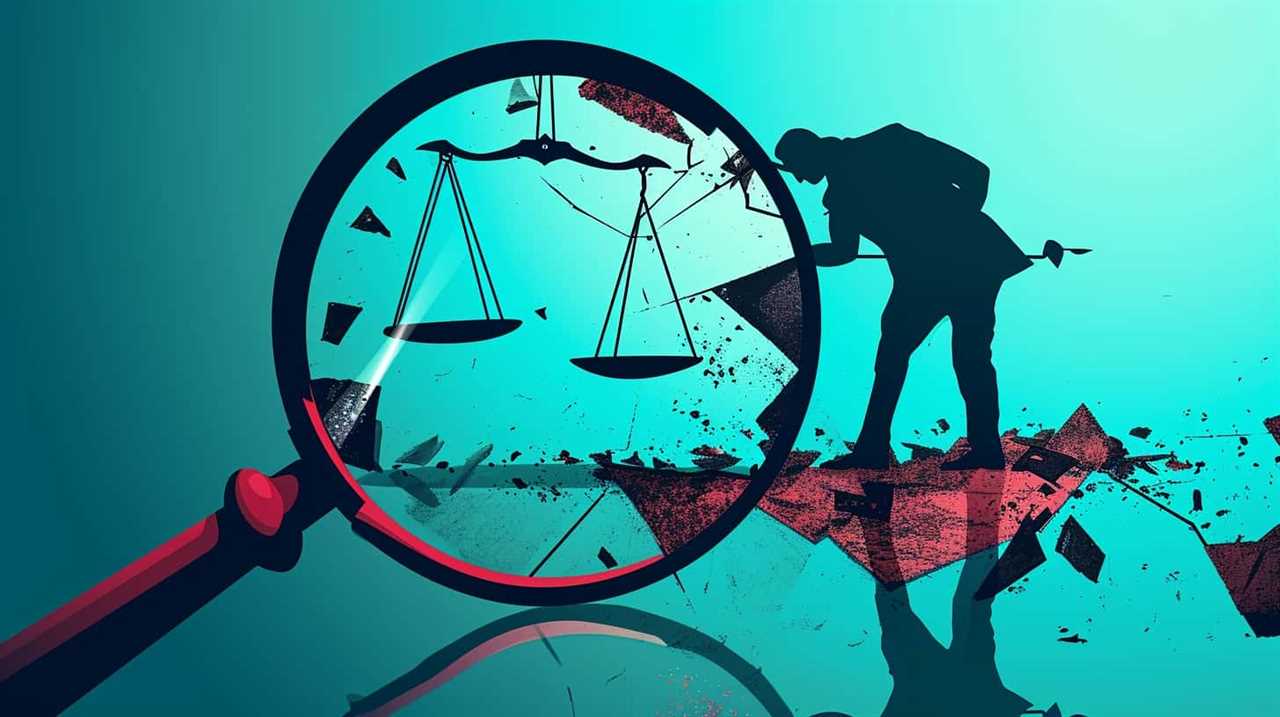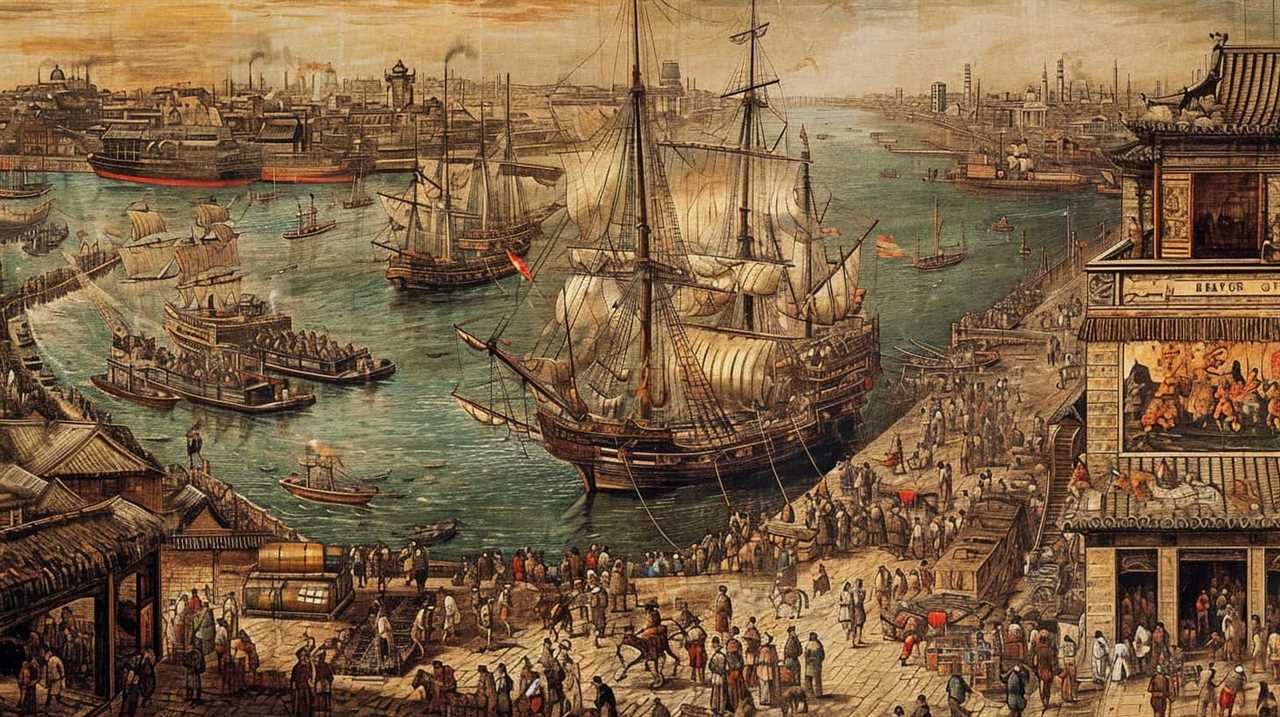Are you ready to delve into the core principles of Marx’s economic philosophy?
In this short introduction, we, as a collective, will delve into the eight essential principles that form the bedrock of Marx’s revolutionary ideas. Prepare to embark on a journey of innovation and critical thinking as we explore concepts such as historical materialism, dialectical materialism, and the labor theory of value.
We will unravel the intricate dynamics of class struggle, alienation, and exploitation that underpin capitalist societies. By examining Marx’s critique of capitalism, we will challenge traditional notions and pave the way for a new, more equitable future.
Finally, we will embrace the transformative power of the socialist revolution and advocate for communal ownership of the means of production.

Let’s embark on this intellectual quest together!
Key Takeaways
- Historical Materialism and Dialectical Materialism form the foundations of Marx’s economic philosophy.
- The dynamics of class struggle and the labor theory of value are central to understanding exploitation under capitalism.
- Criticisms and alternatives to capitalism are explored, highlighting the implications for capitalism and proposing alternative systems.
- The socialist revolution and transition to socialism are discussed, emphasizing the role of class consciousness and mass mobilization in overthrowing the bourgeoisie.
Historical Materialism
In the article, we examine the concept of historical materialism, a key component of Marx’s economic philosophy. Historical materialism, rooted in Marxist theory, is the belief that the development of society is driven primarily by economic factors. It proposes that the mode of production, or the way in which goods are produced and distributed, shapes the social and political structure of a society. According to Marx, economic determinism is the driving force behind historical change.
Historical materialism asserts that different modes of production, such as feudalism, capitalism, and socialism, have distinct characteristics and give rise to specific class structures. These class structures, in turn, shape the relationships and power dynamics within society. For example, in a capitalist society, the bourgeoisie, or the capitalist class, owns and controls the means of production, while the proletariat, or the working class, sells their labor power to survive.
This concept of historical materialism allows us to analyze the dynamics of social change and understand the contradictions and conflicts that arise within capitalist societies. By examining the economic base of society, we can gain insights into the political and ideological superstructure that arises from it.

Understanding historical materialism is crucial for those seeking to innovate and transform society, as it provides a framework for understanding the underlying forces that shape our world.
Dialectical Materialism
Dialectical Materialism serves as the theoretical foundation for understanding social and economic development through a historical materialist analysis.
It recognizes the centrality of class struggle dynamics in shaping societies and their economic systems.
Historical Materialist Analysis
How does historical materialist analysis contribute to our understanding of Marx’s economic philosophy?

Historical materialist analysis, also known as dialectical materialism, is a fundamental aspect of Marx’s economic philosophy. It provides a lens through which we can examine the relationship between economic determinism and material conditions. By analyzing historical developments, social structures, and class struggles, historical materialism allows us to understand how economic systems shape society and influence human behavior.
This analysis highlights the importance of material conditions in shaping social relations and class dynamics. It reveals the underlying contradictions and inherent exploitative nature of capitalism, leading to the inevitable need for a proletarian revolution.
Historical materialist analysis not only provides insights into Marx’s economic philosophy but also offers a framework for understanding and critiquing contemporary economic systems and their impact on society.
Class Struggle Dynamics
Our understanding of Marx’s economic philosophy is deepened by exploring the dynamics of class struggle through the lens of dialectical materialism. Class struggle is at the core of Marx’s analysis of society and serves as a driving force for historical change.

Through the framework of dialectical materialism, Marx examines how power dynamics and social inequality arise from the contradictions inherent in the capitalist mode of production. The capitalist class, or bourgeoisie, possesses the means of production and exploits the working class, or proletariat, who sell their labor power in exchange for wages.
This unequal distribution of power and resources perpetuates social inequality and leads to the antagonistic relationship between the two classes. By understanding the dynamics of class struggle, we can uncover the underlying mechanisms that perpetuate social injustice and work towards a more equitable and just society.
Labor Theory of Value
The labor theory of value posits that the value of a commodity is determined by the amount of socially necessary labor time required to produce it. This theory has been subject to various criticisms and alternatives, including the argument that value is subjective and determined by market forces.
Understanding the implications of the labor theory of value for capitalism is crucial in analyzing the exploitation of labor and the distribution of wealth in capitalist societies.

Value of Labor
As we delve into Marx’s economic philosophy foundations, it is crucial to explore the value of labor through the lens of the Labor Theory of Value. In Marx’s view, the value of a commodity is determined by the socially necessary labor time required for its production. This theory emphasizes the role of technology in shaping the value of labor. With technological advancements, productivity increases, reducing the amount of time needed to produce goods. This leads to a decrease in the value of labor, as more goods can be produced in a given amount of time. Furthermore, Marx distinguishes between wage labor and unpaid labor, highlighting the exploitation of workers who do not receive fair compensation for their labor. This analysis challenges the prevailing capitalist system and calls for a more equitable distribution of wealth.
| Wage Labor | Unpaid Labor | |
|---|---|---|
| Definition | Labor performed in exchange for wages or salary. | Labor that is not compensated with wages or salary. |
| Examples | Factory workers, office employees. | Domestic work, caretaking, voluntary work. |
| Exploitation | Workers are paid less than the value they produce. | Labor is extracted without compensation, leading to profit for the capitalist class. |
| Capitalist System | Relies on wage labor for the production of goods and services. | Relies on unpaid labor for the reproduction of labor power and social reproduction. |
Criticisms and Alternatives
Moving beyond the value of labor, we now turn our attention to the criticisms and alternatives surrounding the Labor Theory of Value.
Marx’s economic philosophy, centered around the idea that the value of a commodity is determined by the amount of socially necessary labor time required for its production, has faced numerous criticisms. One of the main criticisms is that the Labor Theory of Value fails to account for subjective factors such as consumer preferences and market demand. Additionally, critics argue that the theory doesn’t adequately explain the role of capital and entrepreneurship in the creation of value.
As a result, alternative economic theories have emerged that seek to provide a more comprehensive understanding of value creation, such as the subjective theory of value, which emphasizes the importance of individual preferences and market dynamics.

These criticisms and alternative theories highlight the ongoing debates and evolving nature of economic thought. In the subsequent section, we’ll explore the implications of Marx’s economic philosophy for capitalism.
Implications for Capitalism
Now let’s explore the implications of Marx’s economic philosophy for capitalism.
Marx’s labor theory of value has significant implications for the capitalist system, particularly in relation to economic inequality and market competition. Here are four key points to consider:
- Economic Inequality: According to Marx, capitalism inherently leads to economic inequality. The exploitation of labor by capitalists leads to the accumulation of wealth in the hands of a few, while the majority of the population faces poverty and deprivation.
- Exploitation: Marx argues that the labor theory of value exposes the exploitative nature of capitalism. Capitalists extract surplus value from the labor of workers, resulting in profit accumulation at the expense of the working class.
- Market Competition: Marx’s theory suggests that market competition under capitalism intensifies exploitation. As capitalists compete to maximize profits, they drive down wages and working conditions, further exacerbating inequality.
- Crisis Tendency: Marx believed that capitalism had an inherent tendency towards crisis due to its contradictions. The pursuit of profit and market competition can lead to overproduction, financial instability, and economic downturns.
Understanding these implications of Marx’s economic philosophy helps us grasp the underlying dynamics of capitalism and sets the stage for further analysis of the class struggle.

Class Struggle
By analyzing the dynamics of societal power and wealth distribution, we uncover the profound significance of class struggle in Marx’s economic philosophy. Class struggle refers to the conflict between the working class and the capitalist class, arising from the inherent contradictions within capitalism itself. Marx argued that capitalist exploitation and the pursuit of profit would inevitably lead to the alienation and disenfranchisement of the working class.
To better understand the concept of class struggle, let us examine the following table:
| Worker Solidarity | Capitalist Exploitation | |
|---|---|---|
| Definition | The unity and collective action of workers in their fight for better conditions and rights. | The extraction of surplus value from workers by capitalists through the appropriation of their labor. |
| Significance | Empowers workers to challenge capitalist control and demand fair treatment. | Drives the accumulation of wealth by the capitalist class at the expense of the working class. |
| Resistance | Workers organize in unions and engage in strikes to resist exploitation. | Capitalists employ tactics such as wage suppression and labor repression to maintain control. |
| Transformation | Aims to overthrow capitalism and establish a classless society based on equality and cooperation. | Capitalism perpetuates class divisions and reinforces the dominance of the capitalist class. |
Class struggle is a fundamental aspect of Marx’s economic philosophy, highlighting the inherent contradictions and power imbalances within capitalist societies. It serves as a catalyst for change and transformation, as workers strive for better conditions and rights, challenging the exploitative nature of capitalism. Through worker solidarity and collective action, the working class can resist capitalist exploitation and ultimately seek to create a more just and equitable society.
Alienation and Exploitation
As we delve deeper into Marx’s economic philosophy, we must now explore the concept of alienation and exploitation, which continues the analysis of class struggle discussed earlier.

Alienation refers to the separation or estrangement that workers experience from their own labor, the products they create, and the capitalist system itself.
Exploitation, on the other hand, refers to the unfair and unequal treatment of workers by capitalists who profit from their labor.
To further understand the implications of alienation and exploitation on workers within the capitalist system, we must consider the following:
- Loss of control: Workers often have little to no control over the conditions and processes of their labor, leading to a sense of powerlessness and detachment from their work.
- Productivity versus profit: The capitalist system prioritizes profit over the well-being and fulfillment of workers, resulting in the exploitation of their labor for the benefit of the capitalists.
- Dehumanization: The capitalist system reduces workers to mere commodities, treating them as replaceable and disposable, which devalues their worth and dignity.
- Social alienation: The competitive nature of capitalism fosters a sense of isolation among workers, hindering solidarity and collective action against exploitation.
Understanding the effects of alienation and exploitation on workers is crucial in critiquing the capitalist system and striving for innovative alternatives that prioritize the well-being and empowerment of all individuals.

Critique of Capitalism
We will now delve into our critique of capitalism by examining its inherent flaws and shortcomings. Capitalism, as an economic system, has been widely criticized for its tendency to exacerbate inequality, exploit labor, and prioritize profit over the well-being of individuals and society as a whole. One of the fundamental criticisms of capitalism is its inherent tendency to concentrate wealth and power in the hands of a few. This leads to a stark division between the wealthy elite and the working class, resulting in social unrest and a lack of equal opportunities. Furthermore, capitalism is driven by the pursuit of profit, which often prioritizes short-term gains over long-term sustainability and social welfare. This profit-driven motive can lead to environmental degradation, worker exploitation, and the prioritization of shareholder interests over the needs of employees and communities.
To illustrate the shortcomings of capitalism, let us consider the following table:
| Flaws of Capitalism | Alternatives to Capitalism |
|---|---|
| Concentration of wealth | Socialism |
| Exploitation of labor | Communism |
| Short-term focus | Democratic socialism |
| Lack of social welfare | Participatory economics |
While capitalism has been the dominant economic system for centuries, it is important to critically evaluate its flaws and explore alternative models that prioritize social justice, sustainability, and the well-being of all individuals. These alternatives, such as socialism, communism, democratic socialism, and participatory economics, offer different approaches to address the shortcomings of capitalism and create a more equitable and inclusive society. By analyzing the critique of capitalism and exploring alternatives, we can lay the groundwork for innovative economic systems that better serve the needs of humanity.
Socialist Revolution
A key step towards achieving Marx’s economic philosophy foundations is through initiating a transformative socialist revolution. This revolution is essential in dismantling the capitalist system and establishing a classless society. Here are four key aspects to consider regarding the role of the proletariat and the overthrow of bourgeoisie:

- Class Consciousness: The proletariat, or working class, must develop a deep understanding of their exploitation and the inherent contradictions of capitalism. This awareness is crucial for mobilizing the masses and organizing collective action.
- Mass Mobilization: The proletariat needs to unite and organize itself into a powerful force capable of challenging the bourgeoisie. Through strikes, protests, and other forms of direct action, the working class can disrupt the capitalist system and demand its overthrow.
- Overthrow of Bourgeoisie: The socialist revolution aims to overthrow the bourgeoisie, the ruling class that controls the means of production. This entails the seizure of economic and political power by the proletariat and the establishment of a socialist state.
- Transition to Socialism: After the revolution, the proletariat must embark on the path to socialism by implementing policies that prioritize collective ownership, social welfare, and the eradication of class divisions. This transitional period is crucial for building a new society based on cooperation and equality.
Through a transformative socialist revolution, the proletariat can play a central role in restructuring society and laying the foundation for Marx’s economic philosophy. It’s a necessary step towards creating a more just and equitable world.
How Does Marx’s Economic Philosophy Foundations Compare to the Insights on Market Equilibrium Dynamics from Philosophers?
Marx’s economic philosophy foundations differ significantly from philosopher insights on market equilibrium. While Marx focused on the exploitation of labor and the conflict between classes, philosopher insights on market equilibrium emphasize the balance of supply and demand to achieve stability within the market.
Communal Ownership of Means of Production
After understanding the role of the proletariat in the transformative socialist revolution, it’s crucial to delve into the concept of communal ownership of the means of production. In Marx’s economic philosophy, communal ownership refers to the idea that the means of production, such as factories, land, and machinery, should be collectively owned and controlled by the community as a whole, rather than being privately owned by individuals or corporations. This concept arises from Marx’s critique of capitalism, which he believed perpetuated inequality and exploitation through private ownership of productive resources. By advocating for communal ownership, Marx sought to eliminate the class divisions inherent in capitalist societies and create a system where the means of production are used for the benefit of all members of society.
Communal ownership of the means of production represents a fundamental shift in the way economic resources are allocated and managed. In a capitalist system, private owners have the power to determine how resources are used and distributed, often prioritizing their own profit over the well-being of workers and society as a whole. In contrast, communal ownership aims to ensure that resources are used in a way that benefits everyone, with decisions about production and distribution being made collectively and democratically. This approach seeks to eliminate exploitation and promote greater equality and social justice.
Implementing communal ownership of the means of production requires a fundamental reorganization of society and the establishment of new economic and political structures. It involves the abolition of private property in the means of production and the creation of mechanisms for collective decision-making and resource allocation. This can take different forms depending on the specific context and goals of a society, ranging from worker cooperatives to state ownership. Regardless of the specific form, the underlying principle remains the same – that the means of production should be owned and controlled by the community as a whole, rather than being concentrated in the hands of a few.

Communal ownership of the means of production has been a topic of debate and experimentation throughout history. Proponents argue that it provides a more equitable and sustainable alternative to capitalism, promoting social welfare and reducing wealth disparities. They contend that by eliminating profit-driven motives, communal ownership can lead to a more efficient allocation of resources and a fairer distribution of wealth. Additionally, communal ownership allows for greater democratic control over economic decisions, ensuring that they align with the collective interests and values of the community.
Critics, on the other hand, raise concerns about the feasibility and efficiency of communal ownership. They argue that without the profit motive and individual incentives, there may be a lack of innovation, productivity, and accountability. They also question the ability of collective decision-making processes to effectively allocate resources and make efficient economic choices. Additionally, critics argue that communal ownership can lead to a concentration of power in the hands of a few individuals or a central authority, potentially resulting in a loss of individual freedom and autonomy.
Frequently Asked Questions
What Is the Role of Technology in Marx’s Economic Philosophy?
The role of technology in Marx’s economic philosophy is significant. It has a profound impact on labor, transforming production processes and exacerbating class divisions. The integration of technology is crucial for understanding the dynamics of capitalist societies.
How Does Marx’s Theory of Alienation Relate to Modern Work Environments?
Marx’s theory of alienation provides a critical lens through which to examine modern work environments. It highlights the disconnection between workers and the products of their labor, revealing the relevance of Marx’s economic philosophy in today’s society.

What Are Some Key Criticisms of Marx’s Labor Theory of Value?
Critiques of Marx’s labor theory of value include its failure to account for subjective value, the inability to explain price fluctuations, and the lack of consideration for non-labor factors in production. Alternative theories, such as the marginal utility theory, address these concerns.
How Does Marx’s Concept of Class Struggle Apply to Contemporary Society?
Marx’s concept of class struggle in contemporary society remains relevant, as it highlights the ongoing power imbalances and economic inequalities. Additionally, his economic philosophy has relevance in non-industrialized societies, where exploitation and class divisions persist.
Can Marx’s Economic Philosophy Be Applied to Non-Industrialized Societies?
Marx’s economic philosophy can be applied to non-industrialized societies by analyzing the dynamics of class struggle and exploitation within traditional economies. This approach allows for a critical understanding of power relations and potential avenues for social transformation.
Conclusion
In conclusion, Marx’s economic philosophy is built on the foundations of historical materialism, dialectical materialism, the labor theory of value, class struggle, alienation and exploitation, critique of capitalism, socialist revolution, and communal ownership of means of production.

These principles provide a critical and scholarly framework for understanding and analyzing economic systems. For example, the case study of the 2008 financial crisis demonstrates how capitalist economies can lead to systemic instability and inequality, highlighting the necessity for a more equitable and sustainable economic model.
Lauren’s talent in writing is matched by her passion for storytelling. Her love for books and deep understanding of culture and entertainment add a distinct flavor to her work. As our media and press contact, Lauren skillfully bridges the gap between afterQuotes and the broader media landscape, bringing our message to a wider audience.










